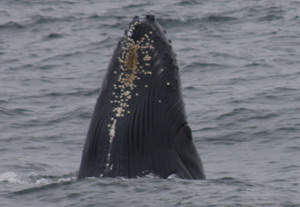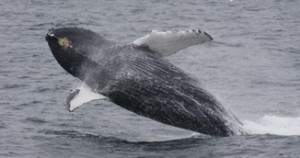Dolphin Fleet Naturalist Notebook 19 July to 25 July
On July 19th our humpbacks were still successfully foraging away. After blowing spiraling clouds of bubbles to trap and confuse fish, groups of over 6 humpback whales were observed, rising to the surface with their mouths wide open, closing in on hundreds of pounds of sand lance with every mouthful. Unlike many species of toothed whales, baleen whales, including the humpbacks, don’t generally require large groups in order to feed successfully. However, if there is a dense concentration of food in a relatively small  area, humpbacks will sometimes feed by working together to trap their target fish species.
area, humpbacks will sometimes feed by working together to trap their target fish species.
The mid-day trip arrived just in time to catch the tail end of this massive feeding frenzy. Fortunately, sated whales can be just as exciting as feeding whales. Alphorn, a large male, along with four other humpbacks gave the Portuguese Princess II a “close boat approach”, and soon the 100 foot long vessel was completely surrounded by humpbacks, swimming back and forth, occasionally rolling over to catch a closer glimpse at the passengers!
By July 20th, the humpback whales of Stellwagen Bank had scattered a bit, but were still easy to locate, predominately along the southern edge of the bank. Here, many were observed using a different feeding strategy — kick feeding. Kick feeding uses the same principal as bubble feeding by exploiting the fact that when fish get scared and confused, they move closer together in a school. Kick feeding adds the extra impact of the whale’s tail hitting the surface of the water to stun the fish. Frequently, the whale will kick and then blow bubbles. Scientists have noticed that this kick feeding behavior is seen most often in the humpback sub-population that frequents the Gulf of Maine. They have also noticed it more and more in recent years. It appears that it is an example of a feeding strategy that is learned through cultural transmission and from mother humpbacks teaching their young how to forage and survive on their own.
July 21stwas a typical hazy summer day. The prevailing southwest winds offered a pleasant, light breeze we headed north to Stellwagen Bank. On our way to the southwest corner of the Sanctuary, we spent a few minutes with the speedy, graceful fin whales just north of Race Point in Provincetown. We are often amazed by how close these animals are to shore, and in fact, today, we could see visitors to Race Point Beach straining to see the spouts only a few miles offshore.
Heading west, careful birders noticed both Pomerine and Parasitic jaegers occasionally swooping down among the terns and gulls. Jaegers are more commonly see in mid-to late summer and are characterized by their agile flight patterns. See this week’s bird update for more information about the latest bird sightings.
Once we reached the southern edge of Stellwagen Bank, we were able to spend some time with Tongs, a 19 year old humpback, and her calf. Tongs’ calf survived an entanglement this past spring, but was fortunately disentangled by the rescue team the Provincetown  Center for Coastal Studies. This calf was extremely energetic today, and we were excited to see it spyhop, peering up at the boat above the water line and revealing its barnacle-encrusted chin!
Center for Coastal Studies. This calf was extremely energetic today, and we were excited to see it spyhop, peering up at the boat above the water line and revealing its barnacle-encrusted chin!
As if this little calf hadn’t provided enough excitement for this trip, it suddenly dove very quickly and then breached, completely clearing the water with its flippers pressed against its 15 foot long body!
On July 22, we spent time with several fin whales in an area sometimes referred to as “Finback Alley”. This stretch of beach between Race Point in Provincetown and Highland Light in Truro is frequently the favorite spot for some of the earth’s largest creatures. The fin whale is the second largest animal on the planet, only slightly dwarfed by the blue whale. We stopped to watch these fin whales glide effortlessly through the water, sometimes allowing us to see the bright white patches which highlight their lower right jaws.
Despite their impressive speed, fin whales are subject to many of the same threats as humpbacks and right whales, including ship strikes. Unfortunately, many of our fin whales have propeller scars across their backs and sides. While this is a sad comment on the fragile relationship between humans and their marine environments, we can use photographs of these scars to identify individual animals and to better understand the threats that they face so that we can build conservation strategies to address these threats.
On July 23rdwe started to notice some of the lingering effects of the tropical storms swirling offshore and to the south, and we spent much of our morning peering into the fog, hoping to find whales in the area where we had been seeing them for the past few days. After an hour’s journey offshore, we succeeded in finding a group of humpbacks and proceeded to get a close boat approach from Echo’s 2008 calf. As Echo waited nearby, her calf rolled around, sometimes flipper slapping, so close to the boat that we were held captive for approximately thirty minutes. We considered ourselves lucky that on such a foggy day, with visibility sometimes maxing out at 100 feet, many other large whales, including Trident and her calf, cruised by us very close, headed right at us, and dove under the bow while we were stopped in an area to the east of Stellwagen Bank known as “The Triangle”.
On the way back out for the evening trip, we passed through a huge rainstorm, and lightning streaked the sky in the distance. Once we reached the Stellwagen Bank National Marine Sanctuary, the rain had dropped off to a drizzle, and some of the fog had lifted so that we could see a rainbow stretching across the sky. Here, we found a group of four humpbacks, including one calf. It was clear that the calf was trying to imitate its mom by raising its tail, or fluking, but it was clear with each dive that he or she just wasn’t quite ready yet! The calf did, however, prove itself in the end by imitating its mom by lobtailing, or slapping its tail down on the water. Despite the less than desirable weather, it turned out to be a very exciting trip!
By June 24thwe still hadn’t escaped the clutches of the low-pressure weather system, but many brave whale watchers decided to don a poncho and go out in search of whales just the same. Although winds from the south made it very choppy off of Wood End Lighthouse in Provincetown, once we rounded Race Point and headed east towards the Triangle it was smooth sailing towards the many visible spouts on the horizon.
We had a few good looks at some fin whales along the way, but we had our eyes trained on the whales further to the north, especially when we started to see white water and big groups of birds congregated near the water’s surface. When we arrived on the scene, we found a whale named Abrasion who had a very distinct style of kick feeding. Abrasion would dive and then quickly resur face. Then, she would pump her tail to stop quickly and kick. Diving a second time, she would blow three or four bubble columns and come up with her mouth open, full of fish!
face. Then, she would pump her tail to stop quickly and kick. Diving a second time, she would blow three or four bubble columns and come up with her mouth open, full of fish!
On July 25the winds had died down and by mid-morning the fog had cleared. We had all three species of baleen whales that frequent the waters surrounding Cape Cod during the summer months. The humpbacks, the fin whales, and the Minke whales are baleen whales, but they are also classified as “rorquals”, meaning that they have folds of skin which run down their belly from their chin to their navel. These folds expand when the whales feed to accommodate large volumes of food and water. Typically, rorqual whales feed on small schooling fish which are abundant in the cold, nutrient-rich waters of the North Atlantic.
Today, we recognized many familiar humpbacks including Barb, a male born in 1987 to a female named Veil. Bandit, a male first seen in 1988 was up to his usual frantic kick feeding behavior. We could recognize him from miles away as soon as we saw his tail slashing and kicking up bursts of spray as he fed off the southern edge of Stellwagen Bank.







